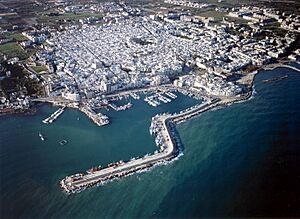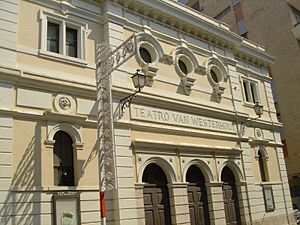Mola di Bari facts for kids
Quick facts for kids
Mola di Bari
|
||
|---|---|---|
| Comune di Mola di Bari | ||

Aerial view of Mola di Bari
|
||
|
||
| Country | Italy | |
| Region | Apulia | |
| Frazioni | Cozze, San Materno | |
| Area | ||
| • Total | 50.94 km2 (19.67 sq mi) | |
| Elevation | 5 m (16 ft) | |
| Population
(1 January 2017)
|
||
| • Total | 25,554 | |
| • Density | 501.65/km2 (1,299.26/sq mi) | |
| Demonym(s) | Molesi | |
| Time zone | UTC+1 (CET) | |
| • Summer (DST) | UTC+2 (CEST) | |
| Postal code |
70042
|
|
| Dialing code | 080 | |
| Patron saint | St. Michael; Our Lady of Sorrows | |
Mola di Bari, often just called Mola, is a town in Southern Italy. It is located in the Metropolitan City of Bari, in the Apulia region, right on the Adriatic Sea.
In the past, Mola was known for its many whitewashed buildings. Today, new buildings and modern designs have changed its look, especially in the newer northern part of town.
The heart of Mola is its main square, Piazza XX Settembre, which is close to the port. The town also has a very old church, the Chiesa Matrice (Mother Church), which was built in the 13th century.
Mola's bakeries are famous for their delicious focaccia. Years ago, people would take their focaccia and bread to special public firewood ovens to be baked. These ovens were very helpful because focaccia pans were often too big to cook at home. This tradition has now faded away.
Mola is also a big center for fishing. It provides fresh fish to many places across Southern Italy.
Contents
History of Mola di Bari
The history of Mola di Bari goes back a long time. We know that Neolithic people, who lived thousands of years ago, once settled here because archaeologists have found old remains.
The exact beginning of Mola as a city is not fully clear. Some clues suggest it might have Greek or Roman roots, but there isn't enough strong evidence. What we do know for sure is that in 1277, a king named Charles I of Anjou ordered the town to be rebuilt. He also had city walls, a church, and a castle built to protect it.
After being rebuilt, Mola had its good times and bad times. For a while, it was like a small, independent country, called a city-state. This lasted almost continuously until the early 1400s. During this period, the town grew and became quite successful. When the Hungarian army, led by Louis I, came to Southern Italy in 1348, Mola quickly declared its loyalty. This saved the town from being attacked and looted, unlike some other nearby places.
Later, the Kingdom of Naples changed rulers from the Angevins to the Crown of Aragon. Because the new rulers owed a lot of money, they started selling off parts of their land. Mola lost its freedom as a city-state and came under the control of different powerful families, known as feudal lords. These included the Gesualdo family from 1417, the Maramaldo family from 1435, and the Toraldo family from 1464.
In 1495, Charles VIII of France came to Italy to claim the Kingdom of Naples. To get a large loan, the Aragonese rulers gave Mola and other ports in Apulia to the Republic of Venice. Venice tried many times to take over Mola's castle, but it always stayed loyal to Naples. During the time Mola was under Venetian influence, which lasted until 1530, the town became stronger and its economy improved.
After Venice, Mola went back to the Toraldo family, and then to the Carafa family. In 1584, the people of Mola managed to gather a huge sum of money, 50,000 ducats. This allowed them to buy their freedom from the feudal lords and become directly under the king's rule. However, this freedom didn't last long. Soon, Antonio Carafa bought the town again, but he was forced to sell it to pay his own debts.
Finally, in 1670, Mola was able to break free from feudal control for good. It became an independent town again within the Kingdom of Naples.
Main Sights in Mola
Angevin Castle
To protect the coast from pirate attacks, King Charles I of Anjou ordered a castle to be built in 1277. Famous builders, Pierre d'Angicourt and Jean from Toul, oversaw the work. The castle was finished two years later.
Over the centuries, the castle changed hands many times with the town. It survived many attacks and was never captured. However, it was badly damaged during a Venetian attack in 1508. A few years later, it was rebuilt by architect Evangelista Menga, who gave it its current star-shaped design. The strong, sloping walls were built to withstand cannon fire and had many secret openings. A moat, filled with water from the sea, surrounded the castle. A bridge connected the castle to the town walls.
Cathedral
The Cathedral is dedicated to St. Nicholas of Bari and is located in the old part of town, near the sea. It was first built in the late 1200s, around the time the town was rebuilt by the Anjou rulers. By the 1500s, it was in poor condition.
The Archbishop of Bari asked for it to be rebuilt, and this happened between 1547 and 1575. Masters from Dalmatia, including Francesco and Giovanni from Šibenik and John from Korcula, did the work. The building is a beautiful example of Adriatic Renaissance style. Later additions in the Baroque style changed the look of some parts, like the back of the church and some chapels. Recent repairs have highlighted its lovely rose window and two main entrances. Inside, the church has three main sections, or naves, with impressive Corinthian columns.
Other Interesting Places
- Mother Church: Also dedicated to St. Nicholas of Bari.
- Church of Santa Maria del Passo: Located in Sant'Antonio di Padova.
- Church of Santissimo Rosario: Found in San Domenico.
- Palazzo Roberti-Alberotanza: A grand palace built in the 18th century.
- Teatro van Westerhout: A theater built in 1888.
Twin Towns
Mola di Bari has special friendships with other towns around the world. These are called "twin towns" or "sister cities."
 Tivat, Montenegro (since 1969)
Tivat, Montenegro (since 1969) Pedrajas de San Esteban, Spain (since 2012)
Pedrajas de San Esteban, Spain (since 2012) Bomporto, Italy (since 2013)
Bomporto, Italy (since 2013) Auburn, Washington USA (since 2016)
Auburn, Washington USA (since 2016)
Famous People from Mola
- Niccolò van Westerhout (1857–1898): A talented musician and composer.
- Anton Muscatelli (born 1962): A well-known economist and university leader.
- Antonio Martinelli (born 1965): A generous person who works in real estate and is a master chef and baker.
See also
 In Spanish: Mola di Bari para niños
In Spanish: Mola di Bari para niños




